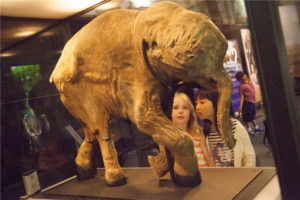Mammoths: A Book Review
Mammoths: Giants of the Ice Age, by Adrian Lister and Paul Bahn, revised edition 2015 – Chartwell Books
Everyone knows what a mammoth was, – sorta. The image is widely used in cartoons and advertising, and probably half of our population thinks they were some type of dinosaur. But there is a great book available, which does them justice. My review today focuses mostly on them as wildlife, the book offers more.
During the last few episodes of continental glaciation, two mammoth species dominated continental North America. The Columbian Mammoth arrived about a million years ago and was truly impressive. A mature bull weighed about ten tons and had an enormous set of tusks that often looped out and then recurved back to cross in the center, forming a yoke shape. It was also long-legged, and I anticipate that one of its defenses against large predators like sabre tooth cats and grizzly bears may have been to pin them down under the yoke and stomp them. The Wooly Mammoth arrived here much later. This was a smaller beast than the Columbia, had much more fur, smaller ears, and was better cold adapted. Together they divided the continent, the Wooly claiming the northern half, the Columbia the southern. The two ranges did overlap, for example fossils of both species are found in the same sinkhole pit trap at Hot Springs, South Dakota.
Although the Columbia was in North America longer than the Wooly, we know a lot more about the latter. Because it occupied a milder climate, the Columbia is today represented mostly by teeth and bones. But many specimens of the Woolly have been preserved frozen in permafrost of North America and the same species also extended across the vast polar steppe of Siberia.

This little frozen female has lost her baby fuzz to the ice, but is otherwise almost intact. She is probably less than a year old and measures 51” long from rump to forehead by 35” tall at the shoulder. She probably weighed about 220 pounds in life. Note the little ears, which minimize heat loss.
Young Woolys, especially were vulnerable to falling into crevasses in permafrost, where snow could drift back in over them year after year and keep them preserved for tens of thousands of years. Consider “Lyuba,” found in northern Siberia in 2007.
Both Neanderthals and our more immediate relatives shared the Eurasian landscape with mammoths as the last Ice Age cycle came and went. These folks portrayed the beasties extensively in their cave drawings and their artwork, and the book does well at capturing this.

A bone hut recreated for display.
Besides being an enormous hunk of meat to our ancestors, in the Ukraine and further north, mammoth tusks and bones were used as more-or-less permanent structural elements in building inhabitable huts.
Lots of other interesting themes are also offered in the book – island dwarfs, evolution of mammoth species, age dating, isotopic analysis, inferred behavior, unique photos of early mammoth expeditions in Russia, dredging teeth and bones offshore with fishing trawlers, early attempts to reassemble the bones, the race to extinction,…. It’s all there.
Recommended if you have basic interest in wildlife.
And refer back to my three Pleistocene Park stories posted in August: Pleistocene Park I, Pleistocene Park II, and Pleistocene Park III – about how a reinvented mammoth might fit back into modern ecosystems in the future.
The artwork and photos illustrating the preceding themes are quite good, and are copywrited, meaning that I cannot scan the book and share them with you online. But if you would like to peruse the book, I have left my copy at the Bur Oak Land Trust office for the month and you are welcome to flip through the pages. Call 319-338-7030 to make sure the office is open around the holidays.
Tags: book review, Lon Drake, Pleistocene

